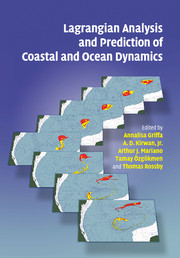Book contents
- Frontmatter
- Contents
- List of contributors
- Preface
- 1 Evolution of Lagrangian methods in oceanography
- 2 Measuring surface currents with Surface Velocity Program drifters: the instrument, its data, and some recent results
- 3 Favorite trajectories
- 4 Particle motion in a sea of eddies
- 5 Inertial particle dynamics on the rotating Earth
- 6 Predictability of Lagrangian motion in the upper ocean
- 7 Lagrangian data assimilation in ocean general circulation models
- 8 Dynamic consistency and Lagrangian data in oceanography: mapping, assimilation, and optimization schemes
- 9 Observing turbulence regimes and Lagrangian dispersal properties in the oceans
- 10 Lagrangian biophysical dynamics
- 11 Plankton: Lagrangian inhabitants of the sea
- 12 A Lagrangian stochastic model for the dynamics of a stage structured population. Application to a copepod population
- 13 Lagrangian analysis and prediction of coastal and ocean dynamics (LAPCOD)
- Index
- Plate section
- References
11 - Plankton: Lagrangian inhabitants of the sea
Published online by Cambridge University Press: 07 September 2009
- Frontmatter
- Contents
- List of contributors
- Preface
- 1 Evolution of Lagrangian methods in oceanography
- 2 Measuring surface currents with Surface Velocity Program drifters: the instrument, its data, and some recent results
- 3 Favorite trajectories
- 4 Particle motion in a sea of eddies
- 5 Inertial particle dynamics on the rotating Earth
- 6 Predictability of Lagrangian motion in the upper ocean
- 7 Lagrangian data assimilation in ocean general circulation models
- 8 Dynamic consistency and Lagrangian data in oceanography: mapping, assimilation, and optimization schemes
- 9 Observing turbulence regimes and Lagrangian dispersal properties in the oceans
- 10 Lagrangian biophysical dynamics
- 11 Plankton: Lagrangian inhabitants of the sea
- 12 A Lagrangian stochastic model for the dynamics of a stage structured population. Application to a copepod population
- 13 Lagrangian analysis and prediction of coastal and ocean dynamics (LAPCOD)
- Index
- Plate section
- References
Summary
Introduction
Plankton have inhabited the Earth's oceans for hundreds of millions of years as evidenced by the fossil record. The exterior covering of identifiable dinoflagellates, for example, are well preserved in Mesozoic rock strata. Pelagic diatoms possess siliceous frustules with identifiable species dating from early Cretaceous sediments (see Falkowski et al., 2004). Given the extent of fossil plankton, it is apparent that a drifting mode of life has been a successful means for survival in the sea for much of life's history.
With the importance of plankton in marine ecosystems, it is surprising that biological oceanographers have only recently begun to use drifting, or more formally Lagrangian, techniques. However, as with other aspects of biological oceanography, the Lagrangian ‘tools’ for studying plankton are relatively recent, and have often followed technique development by physical oceanographers and engineers. The main goal of this chapter is to summarize how biological oceanographers have applied Lagrangian and related methods to further our understanding of oceanic plankton distributions and dynamics, as well as biogeochemical processes. Our target audience is physical oceanographers and mathematicians who will hopefully gain some benefit from this exercise, while biological oceanographers may also be encouraged to further consider Lagrangian approaches in their field studies. We include studies on bacterio-, phyto-, zoo-, and ichthyoplankton and discuss the advances made in specific sub-disciplines of biological oceanography through the use of Lagrangian techniques. This review is timely in that new, low power sensors are now being adapted for deployments on a variety of Lagrangian platforms.
- Type
- Chapter
- Information
- Lagrangian Analysis and Prediction of Coastal and Ocean Dynamics , pp. 349 - 400Publisher: Cambridge University PressPrint publication year: 2007
References
- 1
- Cited by

